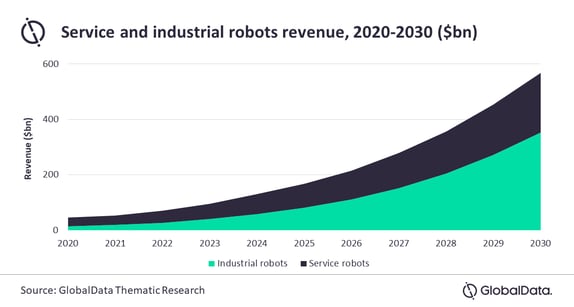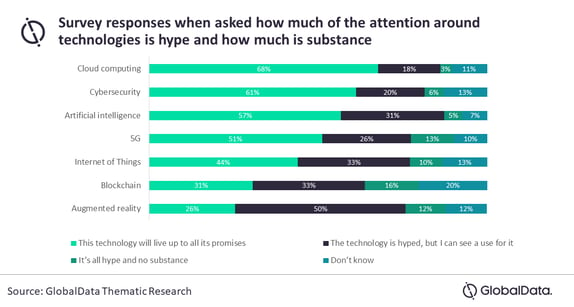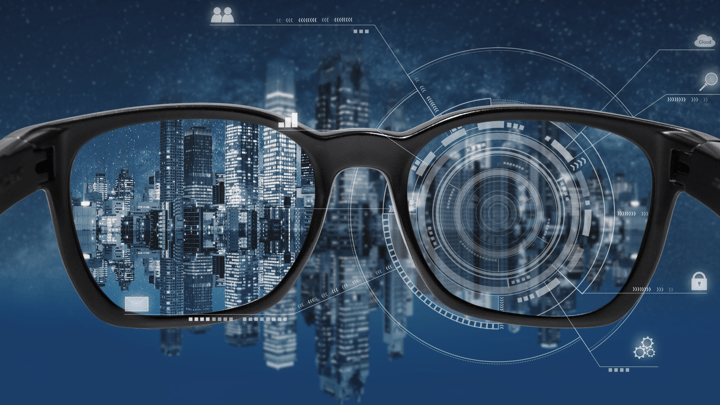Robots have not taken over the world yet, but there will definitely be a lot more of them by the end of the decade.
ARCHIVE FOR THE ‘globaldata’ CATEGORY
Sep 30, 2021 • News • Artificial intelligence • Digital Transformation • Robotics • GlobalData • GLOBAL
Robots have not taken over the world yet, but there will definitely be a lot more of them by the end of the decade.
GlobalData, a leading data and analytics company, forecasts that the robotics industry will pass the $500bn mark in 2030, after a decade of growing at double-digit rates. That is an impressive figure for an industry that generated global revenue of just $45.3bn in 2020.
IN THE NEXT DECADE, INCENTIVES FOR ROBOTICS ADOPTION WILL COME FROM ECONOMIC AND DEMOGRAPHIC TRENDS.
GlobalData’s recent report, ‘Thematic Report: Robotics 2021’, reveals that most of the value generated by robotics comes from service robots, a broad category that includes consumer robots, as well as robots used in logistics, healthcare, security, and many other areas of the service sector. However, industrial robots will grow at a faster rate in the 2020s. Moreover, industrial robots are also a source of innovation that often spills over to service robots.

Filipe Oliveira, Senior Analyst at GlobalData, comments: “Despite the long history of robotics, there is sometimes the feeling that the industry has not reached its full potential. That is about to change due to technological breakthroughs and other factors like the economics and demographics of rich and middle-income countries”.
GlobalData’s report predicts that several conditions are aligned that promise to expand the robotics market. Cloud computing and AI-enabled robots to collaborate, access huge amounts of data uninterruptedly, and, ultimately, become smarter. Further advances are needed in certain AI technologies, including computer vision, conversational platforms, and context-aware computing, and these developments will not happen overnight. Still, the foundations are in place, and advances are expected over the coming years.
Oliveira adds: “Technological developments are important, but on their own will not drive growth. For technology to enjoy wide adoption, it’s not enough for it simply to exist. Whereas scientific ingenuity and creativity are making progress in robotics possible, demographics and the economy will provide the incentives for that technology to be harnessed.”
Before the pandemic, economic growth had started to stagnate in large parts of the world. As countries and companies design their plans to recover from the pandemic, interest in robotics is increasing.
The final incentive for robotics growth comes from demographic trends. Fertility rates are low across all of the developed world, and have declined sharply in middle-income countries too. Societies are looking at robots to care for the elderly and help solve shortages in the workforce.
In the next decade, incentives for robotics adoption will come from economic and demographic trends, and it is the convergence of these trends with technological breakthroughs that promises to unlock the full potential of robots.
Further Reading:
- Read more about Digital Transformation @ www.fieldservicenews.com/digital-transformation
- Read more about Robotics on Field Service News @ www.fieldservicenews.com/robotics
- Read more about Artificial Intelligence on Field Service News @ www.fieldservicenews.com/artificial-intelligence
- Find out more more about GlobalData @ www.globaldata.com
- Read more about GlobalData on Field Service News @ www.fieldservicenews.com/globaldata
Aug 17, 2021 • News • Artificial intelligence • Augmented Reality • Digital Transformation • GlobalData • GLOBAL
Augmented reality (AR) has replaced artificial intelligence (AI) as the most disruptive emerging technology, according to a survey by GlobalData, a leading data and analytics company.
Augmented reality (AR) has replaced artificial intelligence (AI) as the most disruptive emerging technology, according to a survey by GlobalData, a leading data and analytics company.
GlobalData’s latest report, ‘Emerging Technology Sentiment Analysis Q2 2021’, reveals that 70%* of industry professionals surveyed stated that AR would disrupt their industry most out of a selection of seven emerging technologies AI, cybersecurity, cloud computing, IoT, blockchain, and 5G, in addition to AR. This was a sharp increase from the previous quarter, where only 51% selected AR. In addition, 58% said they had become more positive towards the technology over the last 12 months.
AR IS EXPECTED TO BECOME MORE DISRUPTIVE THAN AI, 5G, BLOCKCHAIN AND OTHER EMERGING TECHNOLOGIES.
Filipe Oliveira, Senior Analyst at GlobalData, commented: “This change in how people see AR will likely be long term, and not just a temporary blip. It is clear that people are warming towards the technology, even if they don’t believe that it will make a big difference tomorrow.”
When asked when AR will disrupt their industries, survey respondents were cautious. They expect the impact to be felt later in the decade. While more than half of Q2 respondents said that cybersecurity and cloud computing are already disrupting their industries, only 24% said the same about AR. Moreover, only 10% think that the disruption will come in the next 12 months.

The same pattern was observed when respondents were asked which technologies would live up to all their promises. More than 60% expected cloud computing and cybersecurity to deliver fully, but only 26% expected the same from AR. Further, 50% of respondents said that the technology was hyped, but they could see a use for it.
Oliveira added: “The contrast between the large share of respondents that said AR is disruptive and the low share that said AR was already disrupting their industry suggests that there is some way to go before AR becomes ubiquitous in business. However, several conditions are aligned to make the promotion of AR as a business tool easier.”
COVID-19 has put some AR use cases in the spotlight, namely in healthcare and ecommerce, and new uses are continuing to emerge. For example, in April, Delta Air Lines announced that it would equip all flight attendants with AR technology delivered via 5G to enhance training and help staff with in-flight catering.
Further Reading:
- Read more about Digital Transformation @ www.fieldservicenews.com/digital-transformation
- Read more about Augmented Reality on Field Service News @ www.fieldservicenews.com/augmented-reality
- Read more about Artificial Intelligence on Field Service News @ www.fieldservicenews.com/artificial-intelligence
- Find out more more about GlobalData @ www.globaldata.com
- Read more about GlobalData on Field Service News @ www.fieldservicenews.com/globaldata
Aug 06, 2021 • News • Digital Transformation • healthcare • GlobalData • GLOBAL • Pharma
As pharma companies continue to scale up digital transformation processes, a survey by GlobalData has highlighted that teaming up with experienced external vendors is driving innovative technology implementation.
As pharma companies continue to scale up digital transformation processes, a survey by GlobalData has highlighted that teaming up with experienced external vendors is driving innovative technology implementation.
The leading data and analytics company notes that technologies such as 5G, IoT, sensors, blockchain, cloud and virtual/augmented reality were the top technologies for which pharma companies used external vendors, whereas they were more likely to develop artificial intelligence (AI), big data/analytics or robotics in house comparing to the rest of smart technologies.
IMPLEMENTING SMART TECHNOLOGIES INTO PHARMACEUTICAL PROCESSES REQUIRES FINANCIAL RESOURCES, TIME AND KNOWLEDGE.
The survey, which was published in GlobalData’s latest report, ‘Smart Pharma’, revealed that the majority of healthcare professionals would turn to external vendors to implement 5G to their processes, at 65% of respondents. This was followed by Blockchain at 55% and IoT and sensors at 50%. On the other hand, 28% of respondents would implement AI in house, followed by big data/analytics and robotics at 26% each.
Urte Jakimaviciute, Senior Director of Market Research at GlobalData, comments: “Implementing smart technologies into pharmaceutical processes requires substantial financial resources, time, and knowledge, especially since the speed of innovation is accelerating rapidly. As pharmaceutical companies continue to revamp their portfolios and digital transformation speeds up, partnering with technology providers becomes a natural step for the industry to take.
“Businesses are more likely to use external vendors to deploy technologies that are less widespread, have fewer use cases, or need to be implemented in short timeframes. While there is no way to slow down the digital transformation, a collaboration with external technology vendors may be a key to success.”

Jakimaviciute continues: “Partnering can enable not only faster adoption of the new technologies, but also bring substantial cost savings. External vendors tend to have specific domain knowledge, and are also fast to respond to any regulatory or compliance requirements that the pharmaceutical sector needs to adhere to.
“Pharma companies are already accustomed to working with external vendors to enhance processes in research and development (R&D), manufacturing and supply chain management. As the need to control the rising costs of pharmaceutical processes is becoming more pressing, leveraging smart technologies is expected to create more sustainable operational models and improve business agility. The companies that can optimize the processes faster are primed to succeed - this forces healthcare industry to pursue more open and collaborative approaches.”
In 2021, Boehringer Ingelheim signed a collaborative agreement with Google Quantum AI to implement quantum computing in pharma R&D; UCB and Microsoft announced a strategic collaboration to combine Microsoft's computational services, cloud, and artificial intelligence (AI) with UCB's drug discovery and development capabilities; Bristol Myers Squibb created a collaboration with Exscientia to use AI to accelerate the discovery.
Further Reading:
- Read more about Digital Transformation @ www.fieldservicenews.com/digital-transformation
- Read more about Technology in the Healthcare sector @ www.fieldservicenews.com/healthcare+technology
- Learn more about the latest GlobalData report "Smart Pharma" @ store.globaldata.com/smart-pharma-thematic-research
- Find out more more about GlobalData @ www.globaldata.com
- Read more about GlobalData on Field Service News @ www.fieldservicenews.com/globaldata
Jul 30, 2021 • News • Mobility • Digital Transformation • APAC • GlobalData
While 5G is being widely deployed on a global basis, we haven’t even begun to see the full potential of this technology, according to GlobalData.
While 5G is being widely deployed on a global basis, we haven’t even begun to see the full potential of this technology, according to GlobalData.
The leading data and analytics company notes that 5G is yet to make a significant mark in terms of the faster data speeds, latency and other hallmarks that will enable advanced features such as self-driving cars and immerse gaming. However, more advanced telecom bundles are appearing, and GlobalData expects 5G subscriptions to increase as more powerful applications come through.
THERE WILL BE 3.9 BILLION 5G MOBILE SUBSCRIPTIONS GLOBALLY BY THE END OF 2026, WITH WORLDWIDE SERVICE REVENUES EXPECTED TO HIT $609BN
Lynnette Luna, Principal Analyst with GlobalData, comments: “Although we have not yet seen all that 5G is capable of in early deployments, the technology has a multitude of future opportunities for telecom operators. Not only will capacity bring down the per-bit cost for carriers, the basic cost efficiencies that 5G brings will enable operators and developers alike to create new applications for the technology as it becomes to mature and develop.
“This growing innovation will contribute to an expected rise in 5G mobile subscriptions worldwide. At the end of 2026, GlobalData predicts there will be 3.9 billion such subscriptions, representing a whole 35.1% of total subscriptions. Global 5G service revenues will total $609bn.”
Some revenue-generating strategies seen in the US and Europe on 4G networks also resonate on 5G networks. Within the US postpaid wireless market in particular, operators have always enticed users to sign up for premium plans through service bundles, such as video streaming and gaming.
Luna adds: “5G ARPU in 2026 is expected by GlobalData to greatly outpace that of earlier technology generations, with 5G bringing in monthly ARPU of $14.15 per month versus 4G’s monthly ARPU of $5.48.”
In some markets, we are beginning to see more advanced bundles marketed with 5G. Vodafone is in the process of rolling out Nreal smart glasses in its 5G markets across Europe, offering an interest-free hardware bundle and an app called Vodafone 5G Reality AR. In addition, a number of 5G operators are beginning to sell cloud gaming services. Telia in Sweden and EE in the UK are selling Microsoft’s Xbox Game Pass Ultimate memberships that include cloud gaming. Telia customers can also buy a dedicated cloud gaming promotion featuring an Android phone, Telia plan and a free Razer Kishi universal Android controller and the Xbox Game Pass in one bundle.”
Luna concludes: “Operators will continually improve their bundles with new 5G features. Eventually they will take advantage of ultra-low latency and consistent gigabit data speeds.”
Further Reading:
- Read more about Digital Transformation @ www.fieldservicenews.com/digital-transformation
- Read more about 5G @ www.fieldservicenews.com/5g
- Find out more more about GlobalData @ www.globaldata.com
- Read more about GlobalData on Field Service News @ www.fieldservicenews.com/globaldata
- Read more about Mobility on Field Service News @ www.fieldservicenews.com/mobility
Jan 15, 2021 • News • Mobility • Digital Transformation • APAC • GlobalData
Despite the anticipated decline of 5.6% in total value in 2020, the enterprise mobility market in Singapore will maintain a compounded annual growth rate (CAGR) of 8.2% over the 2019-2024 period, driven by the rising adoption of remote working and...
Despite the anticipated decline of 5.6% in total value in 2020, the enterprise mobility market in Singapore will maintain a compounded annual growth rate (CAGR) of 8.2% over the 2019-2024 period, driven by the rising adoption of remote working and bring-your-own-device (BYOD) strategies across enterprises, says GlobalData, a leading data and analytics company.
The uncertainty in business environment created by the COVID-19 pandemic has forced enterprises in Singapore to take a conservative approach towards their ICT spending in 2020, which has hurt the demand prospects for enterprise mobility solutions and services for most part of the year. As business activity picks up, enterprise mobility spending is expected to recover in 2021.
GROWTH IN MOBILITY APPS SEGMENT WILL BE LED BY MOBILE APPLICATION PLATFORM MANAGEMENT
Nidhi Gupta, Technology Analyst at GlobalData, says: “With businesses adapting to the new normal, and allowing employees to work-from-home and use their personal devices to access corporate networks, their investments on enterprise mobility solutions will recover in 2021 and grow up to US$347m in 2024.”
Mobility software/applications comprising mobile application platform management software, mobile content management software, mobile device management software and telecom expense management software categories represent the largest market segment in the enterprise mobility market in Singapore, in terms of value.
Growth in mobility software/applications segment will be led by mobile application platform management (MAPM) software, which is expected register a CAGR of 12.1% over 2019-2024. With several companies expected to retain their remote working strategies even in the post COVID-19 era, their investment on MAPM software, which can equip their remote workforce with enterprise apps and secure access to the same on devices, will increase going forward.
Ms Gupta concludes: “Managed mobility services segment will see its market value grow at 8.1% CAGR during the forecast period. The rising complexity of managing the huge number of mobile devices and apps that connect employees operating remotely with enterprise data and network will be instrumental in driving the demand for managed mobility services.”
Further Reading:
- Read more about Digital Transformation @ https://www.fieldservicenews.com/digital-transformation
- Find out more more about GlobalData @ www.globaldata.com
- Read more about GlobalData on Field Service News @ www.fieldservicenews.com/globaldata
- Read more about Mobility on Field Service News @ www.fieldservicenews.com/mobility
Apr 28, 2020 • News • future of field service • research report • APAC • Edge Computing • GlobalData
Tech that reduces data lag by is set to grow across region and bring benefits to industrial sector.
Tech that reduces data lag by is set to grow across region and bring benefits to industrial sector.
A report from data and analytics company GlobalData says the Asia-Pacific (APAC) region is on the cusp of wide-spread edge computing adoption with industry verticals set to benefit.
Streamlining Service Management
It predicts several sectors in the region taking advantage of the technology including manufacturing, which it says could streamline its industrial processes, improve supply chain movements and even operate heavy equipment more autonomously by adopting the technology.
Driven by Japan and China it foresees APAC second only to North America in terms of the edge computing market, with the two nations together accounting for 61 per cent of its revenue stream. It says the market will grow at an annual compound rate of 21 per cent between 2019 and 2024, reaching a $5.8 billion value.
The rise of edge computing has increased exponentially with the surge in connected assets which require greater band-widths that in some cases, the cloud is unable to cope with, producing lag.
It operates by being geographically closer to a data gathering device where computation is carried out locally avoiding a central processing cloud-based location meaning latency issues can be negated.
Its influence is expected to reach beyond industry, working alongside society's rapidly evolving connected devices ecosystem, including the growth of smart cars and smart cities. As larger data volumes are produced then Edge Computing will be expected to produce swift and accurate processing. Shamim Kahn, Senior Technology Analyst at Global Data says Edge Computing has the capability to keep up with the increase. "Edge computing would be key in handling most of these challenges, as decentralised processing would allow for excellent reponse times and reduced latency," he explained.
Several big tech firms have, in recent weeks, stepped-up their development in the technology including Amazon Web Services who updated their 'Snow' family of edge computing; Microsoft announcing Azure Edge Zones; and Google revealing its Global Mobile Edge Cloud strategy.
Feb 27, 2020 • News • future of field service • mobile applications • Research • GlobalData
Study shows Machine Learning, Cloud and Process Automation key part of software.
Study shows Machine Learning, Cloud and Process Automation key part of software.
The application software sector is undergoing profound and rapid change, according to data and analytics firm GlobalData.
The company’s latest report ‘Tech, Media, & Telecom Trends 2020 – Thematic Research’ reveals how the value was historically all in the application itself but is now driven by the integration of software. Listed below are the top application software technology trends, identified in the study:
Cloud Computing
The cloud is an important model for IT resource delivery. The growth of application programming interfaces (APIs) has made sharing data easier and encouraged the development of new applications. A new wave of platform services will use artificial intelligence (AI) to increase operational efficiency and automate workflow controls. Advanced platforms will enable intelligent apps and improve user experience.
Process automation:
Process automation refers to robotic process automation (RPA), in which new developer technologies will help shore up various phases within the application lifecycle. RPA uses AI, low-code platforms, and software robotics to automate manual processes. Industrial IT providers will continue to invest in RPA innovation.
Machine learning:
Machine learning is a high priority for businesses everywhere. There are relatively few AI specialists, and developing a model is a time-consuming and resource-intensive process. As the market matures, enterprises will incorporate data from a variety of sources into their machine learning models.
ARTIFICIAL INTELLIGENCE (AI) libraries:
To overcome the skills gap, vendors are designing products specifically for people without data science skills. Vendors are offering translation services, speech-to-text, natural language generation, image recognition, and video analysis to non-AI specialists.
Data will become a key differentiator, and an enterprise’s ability to manage and glean insights from it.
Conversational platforms:
Conversational platforms employ a variety of technologies to enable human-like interactions with computer systems. Virtual personal assistants like Amazon’s Alexa or Google’s Assistant can schedule appointments, provide weather updates, and play music based on voice commands. In 2020, application platform providers will develop user interface (UI) tools to support advanced conversational platforms.
Open source AI:
AI relies heavily upon open source (OS) technologies. Google's machine learning framework, TensorFlow, is a prime example of this trend. Released via the Apache OS license in 2015, TensorFlow is currently available to developers across most public cloud platforms. Investment in OS AI technologies will proceed apace, particularly among vendors selling both open and proprietary technologies.
Augmented reality (AR):
AR allows the user to see the real world overlaid with a layer of digital content. Having come to worldwide attention in 2016 with Pokémon Go, the next two years will be pivotal for AR. Its chances of crossing over to the mass consumer and corporate markets will be determined by the richness and variety of AR content, the development of smartphone applications, and the arrival of all-in-one glasses.















 Field Service News is published by 1927 Media Ltd, an independent publisher whose sole focus is on the field service sector. As such our entire resources are focused on helping drive the field service sector forwards and aiming to best serve our industry through honest, incisive and innovative media coverage of the global field service sector.
Field Service News is published by 1927 Media Ltd, an independent publisher whose sole focus is on the field service sector. As such our entire resources are focused on helping drive the field service sector forwards and aiming to best serve our industry through honest, incisive and innovative media coverage of the global field service sector.
Leave a Reply